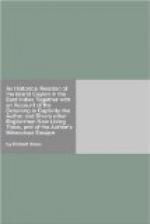[A sort of Rice that grows Without Water.] There is yet another sort of Rice, which will ripen tho’ it stand not alway in Water: and this sort of Corn serves for those places, where they cannot bring their Waters to overflow; this will grow with the Rains that fall; but is not esteemed equal with the others, and differs both in scent and taste from that which groweth in the watery Fields.
[The Seasons of Seed-time and Harvest] The ordinary Season of seed time, is in the Months of July and August, and their Harvest in or about February; but for Land that is well watered, they regard no Season; the Season is all the year long. When they Till their Grounds, or Reap their Corn, they do it by whole Towns generally, all helping each other for Attoms, as they call it; that is, that they may help them as much, or as many days again in their Fields, which accordingly they will do; They Plough only with a crooked piece of Wood, something like an Elbow, which roots up the Ground, as uneven as if it were done by Hogs, and then they overflow it with water.
[A particular description of their Husbandry.] But if any be so curious as to know more particularly how they order and prepare their Lands, and sow their Corn, take this account of it. But before we go to work, it will be convenient first to describe the Tools. [Their Plough.] To begin therefore with their Plough. I said before it was a crooked piece of Wood, it is but little bigger than a Man’s Arm, one end whereof is to hold by, and the other to root up the Ground. In the hollow of this Plough is a piece of Wood fastned some three or four Inches thick, equal with the bredth of the Plough; and at the end of the Plough, is fixt an Iron Plate to keep the Wood from wearing. There is a Beam let in to that part of it that the Plough-man holds in his hand, to which they make their Buffaloes fast to drag it.
[The convenience of these Ploughs.] These Ploughs are proper for this Countrey, because they are lighter, and so may be the more easie for turning, the Fields being short, so that they could not turn with longer, and if heavier, they would sink and be unruly in the mud. These Ploughs bury not the grass as ours do, and there is no need they should. For their endeavour is only to root up the Ground, and so they overflow it with Water, and this rots the Grass.




